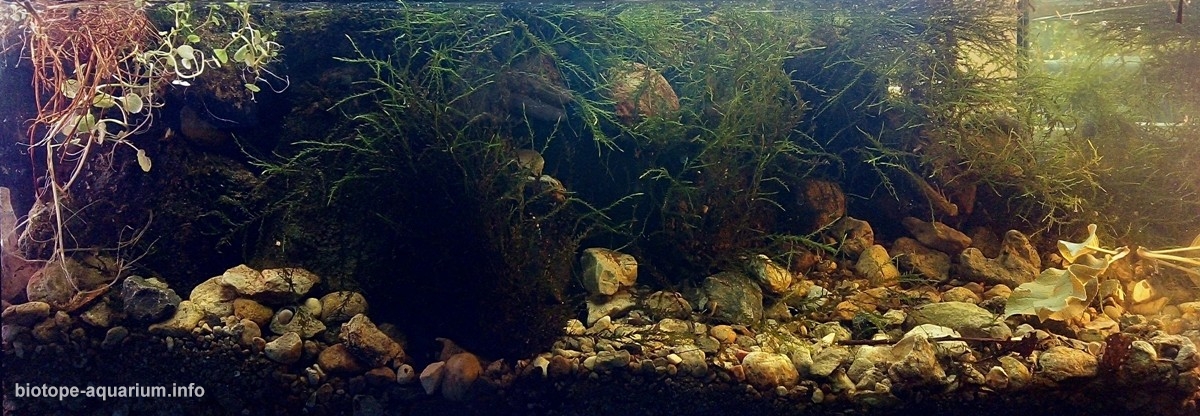Mini waterfall pond, Ribeira da Mata near Sintra, Portugal
103th place in Biotope Aquarium Design Contest 2019
Portugal. João Sol

Volume: c.50L
Dimensions: 60cm x30cm x30cm
List of fishes: radix auriculária
Theodoxus fluviatilis
Anguilla anguilla
Salamandra salamandra
Sympetrum fonscolombii ?
unidentified species
List of plants: Nasturtium officinale
Fontinalis antipyretica
Metzgeriales ?
Description of decorations: stone gravel from the place
Description of equipment: tecatlantis easy flux 600 650 l/h
Water parameters: t. 20°C PH. 7.2
Additional info: The Ribeira da Mata biotope aquarium has as its main purpose to educate my children in the concept that to preserve it is necessary to know, and for that nothing better than to start with what is right in front of our door.
It has been mounted for 3 months, as naturally and simply as possible, it is installed in front of a window that provides relatively the same hours of natural light as there is in the habitat to be recreated, because the dense surrounding trees and the depth of the valley are significant.
I make 20% partial water changes weekly, feed the aquarium fauna with live food, mosquito larvae, cyclops, and small shrimps, so that the animals, being mostly predators, do not lose their hunting instincts as they will be released. at the end of the process (no due date). I have in the aquarium also a specimen I collected on site (like everything else) that I can not identify, (photo6) species of anemone or soft coral clinging to the rocks with the “tentacles” floating, if you can help me identify thank you.
Another aspect of these ponds chosen with reference to the brook has to do with issues related to human activity. At this point of the river there was a Roman bridge that the construction of the current tar bridge eliminated the last vestiges, so this is the only road that passes on this river, and it is the drain point of that same road, which therefore suffers the most. human presence but still, the Fontinalis antipyretic dances in the almost crystal clear waters of an almost stagnant puddle in the summer.
This overlaps an archaeological layer with the biotope as mosses grow on man-cut stones over millennia, collecting, hunting, fishing, farming here, and the anthropological functionality of an exalted Roman bridge on this disturbing new tar bridge.
That is why I also inserted in the decoration of the aquarium stones carved by man, as if it were the base of a small wall already dismembered through which a trickle of water flows quietly.
I feel and love this place also because I grew up in this valley in search of the rare leper Mauremys, which thanks to the gods of natural preservation I never found (I still have scars from these adventures today). The history and strength of geology, hard stone versus water precision, the affectation of human life versus the tenacity of natural life is what makes this place and this project so special.
INFORMATION ABOUT BIOTOPE
Description of the area surrounding the biotope: The Ribeira da Mata basin contains rocks of the volcano-sedimentary complex (sandstones, shales and carbonates), quartzites, shales, rare limestones, turbidites, sands, claystones, sandstones, conglomerates, granite, syenite and gabbro-diorite (Massif de Sintra). Both streams have seven different land use classes. The largest portion of the surface is composed of complex crop patterns (heterogeneous agriculture). There are areas of natural vegetation, coniferous forest, areas occupied by agriculture with significant presence of natural vegetation, areas of undergrowth and chaparros, areas of permanent irrigation and discontinuous urban fabric. They show a higher agricultural pressure compared to urban pressure. As a tree canopy, among the endemic species of the Mediterranean riparian galleries predominate alders (Alnus glutinosa), and ash (Fraxinus angustifolia), sometimes white willows (Salix salviifolia). Shrubs such as hawthorn (Crataegus monogyna) and elderberry (Sambucus nigra), herbaceous plants such as saponaria (Saponaria officinalis) and weed (Oenanthe crocata) and, in the most drenched soils, willow (Lytrhum salicaria) bufonius, Juncus squarrosus, Scirpus holoschoenus) and the boards (Thypha sp).(Celin 2010)
Description of the underwater landscape of the biotope: stones (some carved by humans) sometimes with mosses or bare with gravel hole and small waterfalls and their holes and crevices from the water erosion, also presents trunks of fallen trees and apparently no visible animal life, except for the auricular radix and
Theodoxus fluviatilis.
Description of the parameters of the habitat: running water in winter, almost clear water, wiht annual average temperature from 15 ° C to 16 ° c (celin 2010) but in summer 18 ° c and pH 7.4 (data collected by me)
List of fishes and invertebrates occurring in the nature biotope: radix auriculária
Theodoxus fluviatilis
Anguilla anguilla
Salamandra salamandra
Sympetrum fonscolombii
Mauremys leprosa
List of plants found in the nature biotope: Nasturtium officinale
Fontinalis antipyretica
Metzgeriales
Oenanthe crocata
Lytrhum salicaria
bufonius
Juncus squarrosu
Scirpus holoschoenus
Thypha sp
Threats to the ecology: Essentially human, agricultural and road pressure are the biggest risk of the Habitat, as it has been for millennia. fortunately, I have not seen traces of Procambarus clarkii, gambusia affinis or Trachemys scripta elegans, for example from species that are invasive in Portugal, from the plant point of view, there are problems, with Arundo donax and Lemna minor for example. The risk of eutrophication is not too pronounced because the shade does not allow many algae to grow.
Sources of information: Celin L. P. W. (2010)PLANO DE RESTAURO DE QUALIDADE ECOLÓGICA DE DUAS RIBEIRAS DO OESTE. Instituto Suprior de agronomia da Universidade de Évora
